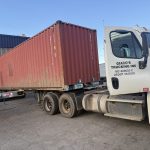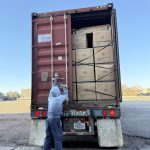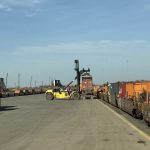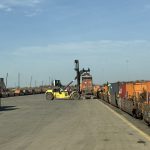By: Morgan Zenner, Director of Marketing at Evans Distribution Systems
The morning was off to a fun start.
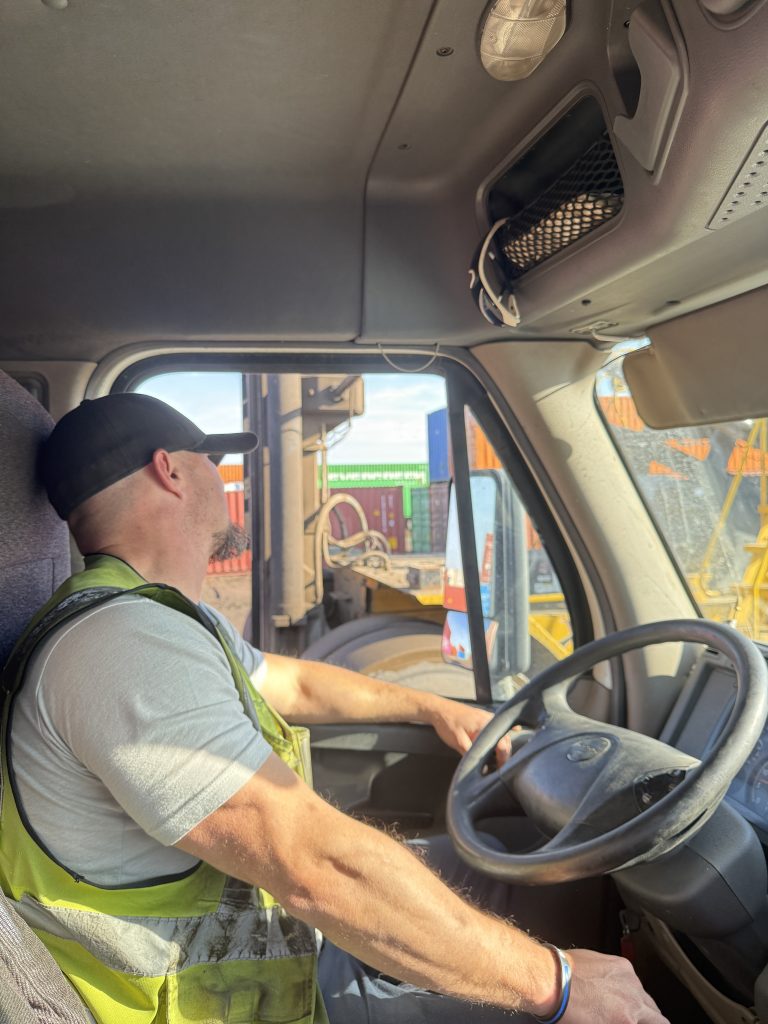
As I approach my first “ride-along” partner, Scott Connochie, it’s evident that something is amiss.
“I accidently set off the fire extinguisher in my cab,” Scott says. He tells me it’s only happened twice in his 20-year driving career.
Nonetheless, there’s no time to dwell when there is a long list of container deliveries on our plate. As I learn, every moment counts in the life a drayage driver who is constantly tested by obstacles throughout the workday.
Scott earned his CDL-A at 22 years old. He graduated from Central Michigan University with a Health Services and Recreation degree but found himself making much more money moving furniture during his summer breaks.
He has a diverse set of driving experiences from over-the-road to white glove relocation services. For the last six years, he has been a drayage driver with Giaco’s Trucking, an exclusive drayage partner of Evans Distribution Systems. Today’s ride-along is no different than the training sessions and driver assessments he conducts when Giaco’s owner, Jeff Giacomantonio, brings on new drivers.
First lesson: Always take time for pre-checks. Cab is clean. Tires are full. Brakes are working. Hazards, blinkers, and brakes lights, check.
We connect to an empty container that was stored at Evans’ Allen Park facility. It’s my first time riding in a truck, and Scott is happy to answer my questions and explain how the chassis works.
Time for the first stop. Once we get on the highway, I realize how different it must feel to drive something that disconnects and reconnects several times a day. If one step or connection point is off, it could lead to an expensive accident or worse. It takes many years of practice and schooling to get to Scott’s level. “I’ve seen it all on the road,” he says. Safety is burned into Scott’s mind from the tragic accidents he’s witnessed over the years, saying, “You cannot be lazy in this line of work.”
With every new container comes a new load weight and shiftability, requiring Scott to adjust his driving to match the load characteristics. He knows his trusty 11-year-old stick shift tractor very well, and he can sense the weight and composition of the container within the first few gear shifts. But he says, it’s always a good idea to know the container specs.
“A 20,000-pound container does not put a lot of stress on the tractor. But when you’re pulling a 56,000-pound container the fastest you will be going in 10th gear is 45 mph,” he says.
As a drayage driver, Scott becomes accustomed to the routine of facilities, people, containers, and rail depots in circulation multiple times per day or week. No Google Maps necessary. He enjoys the people that he meets on the road, albeit, some are friendlier than others.
His driving career has allowed him to see every state in the U.S. other than Alaska. One time, he had the honor of transporting Benjamin Franklin’s armchair! But priorities changed as his family grew and he is happy to work for Giaco’s because it allows him to come home to his loved ones every night.
After we drop an empty container at the first customer location, we exchange it with another empty to return to the rail yard. Containers typically have a 3-day limit to be picked up, unloaded, and dropped off; otherwise customers pay additional storage fees. Professional drayage providers have dispatch teams to optimize routes and avoid fees.
We arrive at the rail yard. This is also a first for me, so I enter with no expectations. Scott tells me this is his least favorite yard, mostly because of turnover and mismanagement. It’s also noticeably lacking certain amenities. The entry point doesn’t seem very secure as Scott’s license number is the only form of identification. The yard is a dirt lot, any hint of moisture creates a thick layer of mud on the tractor, making it hard to see out the window.
Scott heads toward a spot behind a stop sign to get directions on where to leave the empty container. As we wait, he tells me drivers are required to locate their own containers when picking up. After 20 minutes, someone notifies us that we need to drop it in L2, South side. I ask him how he knows where to go with no signs or labels and he says he’s memorized the layout after many years. Thank goodness Scott knows his way around; probably not the case for newcomers like me.
With no signs or process, things can get tricky in the yard. The environment is ripe for miscommunication between drivers, crane operators, and switchers who deploy their individual marching orders with virtually no guidance. One driver comes to our tractor to offer his discontent, pointing out that it’s Friday and he wants to get on with his day. On days when multiple rail cars come in, it can create disaster involving more than 100 trucks. “Things back up quickly and it’s hard to recover,” he tells me.
We find L2 but still don’t have confirmation of where we need to be. Scott recognizes that some containers have hooks on the top needed for stacking and others don’t. We steer clear of the hookless containers and wait for the crane operator to give new directions or release the container from our tractor.
Eventually we head toward another rail yard for our next load. It’s obvious this terminal is a step up from where we were, starting with the self-serve entryway that requires fingerprint identification. Once inside, I notice a beautifully paved yard with plenty of signage including a directional map of the whole yard. We are given an exact location for pickup, and the crane operator is only a few minutes away.
Scott explains this depot has the “Ferrari” of container lift trucks; it can lift a container from two to three rows away.
“Some yards only have a couple crane trucks, and you hope that your container is not buried in the middle under a bunch of other containers,” Scott says. Investments in infrastructure like lift trucks have a huge impact on wait times and operational efficiencies at the yard.
Both rail carriers have apps to pre-load container information to speed up the process but if things are backed up from other inefficiencies the information in the app becomes somewhat useless.
We head back with our new container to the Allen Park facility. The afternoon highway traffic starts to set in. Michigan is known for its highway congestion and poor road conditions. Scott tells me a story about being stuck on a highway for 8 hours; unable to move or make any of his deliveries that day. “It’s hard to let customers down because of that.”
Thankfully we made it out in short order, and Evans’ crew greeted us right away, ready to unload the container and be returned the next day. Success!
My experience only sheds light on a few challenges, but not nearly all. From construction detours, hours of service laws, accidents, port strikes, so much more can happen in this line of work.
My Key Takeaways for Shippers
- Moments that are under a driver’s control like safety, documentation, or start-time, become more valuable to operational success. Utilizing a qualified drayage service provider that has knowledge about routes, facilities, yard operations, rules, or regulations is vitally important.
- There are many reasons why a container cannot be picked up. Build these into realistic timelines so those delays are overcome without charges. Tools like Evans’ ezTracker help shippers do this with real-time container positioning data.
- It may not be wise to cut costs when it comes to selecting rail carriers. Some carriers have more advanced technology, infrastructure, or staff, that could be worth higher upfront costs if it means your containers are pulled more efficiently. Professional drayage providers like Evans can provide insight and recommendations based on real-world experiences at the yard.
- Professionalism goes a long way. Drivers who build relationships with crane operators, dispatch teams, and facility staff, are far more likely to receive service quicker when competing with a long line of drivers. Driver tensions can run high under pressure, but the most experienced providers maintain a professional attitude.
View the photo album below for more! Are you looking for a new drayage partner in Metro Detroit? Let us quote your loads today!

